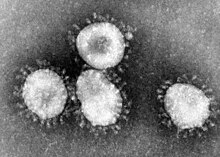
Back Koronavirus Afrikaans ኮሮናቫይረስ Amharic Coronaclēofanwyrm ANG فيروس كورونا Arabic ڤيروس كورونا ARY فيروس كورونا ARZ Orthocoronavirinae AST Koronavirus Azerbaijani کروناویروس AZB Korona BBC
| Orthocoronavirinae | |
|---|---|

| |
| Transmission electron micrograph of Avian coronavirus | |

| |
| Illustration of a SARS-CoV-2 virion[2] Red: spike proteins (S) Yellow: envelope proteins (E) Orange: membrane proteins (M)
| |
| Virus classification | |
| (unranked): | Virus |
| Realm: | incertae sedis |
| Kingdom: | incertae sedis |
| Phylum: | incertae sedis |
| Class: | incertae sedis |
| Order: | Nidovirales |
| Family: | Coronaviridae |
| Subfamily: | Orthocoronavirinae |
| Genera[1] | |
| Synonyms[3][4] | |
| |
Coronaviruses are a group of RNA viruses.[5][6] They cause diseases in birds and mammals, including humans. These diseases can be mild, or they can be fatal. In humans and birds, they cause respiratory tract infections. Mild illnesses in humans include some cases of the common cold (which is also caused by other viruses, for example rhinoviruses). More lethal varieties can cause SARS, MERS, and COVID-19.
They are enveloped viruses with a positive-sense RNA genome.[7] The genome size of coronaviruses is about 26 to 32 kilobases,[8] which is extraordinarily large for an RNA virus. There are four major groups of coronaviruses, called alpha, beta, gamma, and delta.
The most famous coronavirus is one of the betas, the kind that causes Coronavirus disease 2019 (COVID-19) in humans.
The name "coronavirus" comes from the Latin word corona, meaning "crown" or "halo", and refers to how virions look under an electron microscopy (E.M.).[9] They have a fringe of large, bulbous surface projections looking like a crown. This morphology is created by the viral spike (S) peplomer, which are proteins on the surface of the virus. They decide which cells the virus can infect.
Proteins of coronaviruses are the spike (S), envelope (E), membrane (M), and nucleocapsid (N).
- ↑ "Virus Taxonomy: 2018b Release". International Committee on Taxonomy of Viruses (ICTV). March 2019. Archived from the original on 4 March 2018. Retrieved 24 January 2020.
- ↑ Giaimo C (1 April 2020). "The Spiky Blob Seen Around the World". The New York Times. Archived from the original on 2 April 2020. Retrieved 6 April 2020.
- ↑ "2017.012-015S" (xlsx). International Committee on Taxonomy of Viruses (ICTV). October 2018. Archived from the original on 14 May 2019. Retrieved 24 January 2020.
- ↑ de Groot R.J. (2012). "Family Coronaviridae". In King A.M.Q. ' (ed.). Ninth Report of the International Committee on Taxonomy of Viruses. Elsevier, Oxford. pp. 806–828. ISBN 978-0-12-384684-6.
- ↑ International Committee on Taxonomy of Viruses. "ICTV Master Species List 2009 – v10". Archived from the original (xls) on 2013-04-15. Retrieved 2020-03-06.
- ↑ enveloped = has viral envelopes covering their protective protein capsids; positive sense = the RNA sequence may be directly translated into the desired viral proteins.
- ↑ One kilobase = 1000 base pairs
- ↑ virion = complete virus particle.